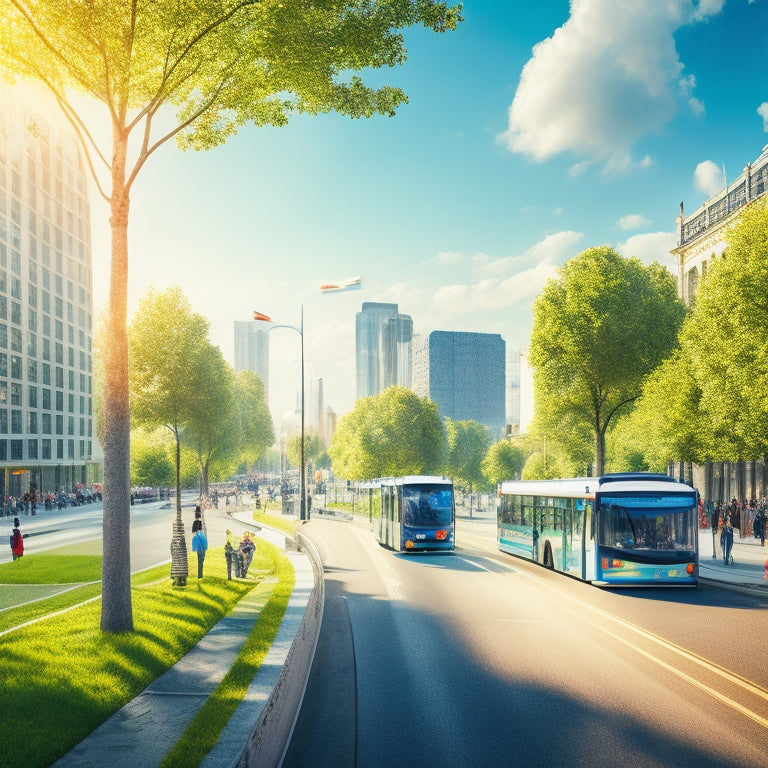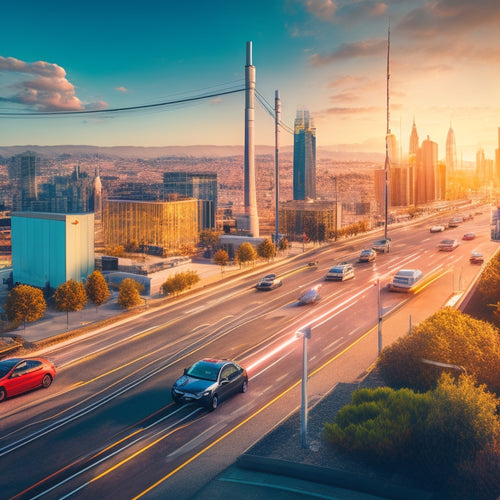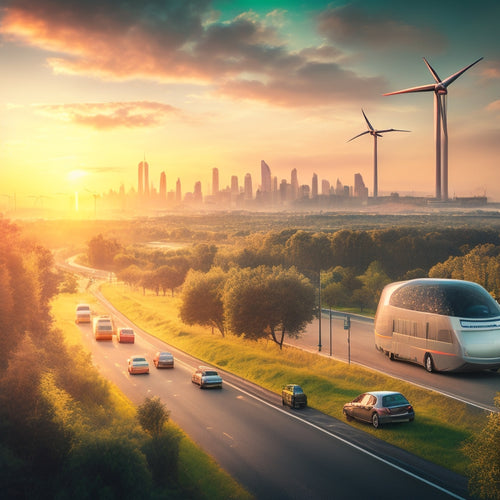
What Makes a City's Transportation System Sustainable?
Share
By incorporating green infrastructure, optimizing public transportation systems, and promoting pedestrian-friendly urban design, you can greatly reduce a city's environmental footprint and improve the overall quality of life for its citizens. This multi-faceted approach can decrease stormwater runoff by up to 90%, diminish urban air pollution by 20%, and optimize travel times by up to 30%. As you explore the key strategies for creating a sustainable transportation system, you'll discover how to integrate green technologies, incentivize electric vehicle adoption, and design intuitive urban infrastructure that supports a healthier, more connected community - and that's just the starting point.
Key Takeaways
• A sustainable transportation system prioritizes pedestrian-friendly infrastructure, including green spaces, walkable sidewalks, and reduced speed limits.
• Efficient public transportation systems, optimized routes, and fare policies encourage the use of shared transportation, reducing emissions and congestion.
• Electric vehicle adoption incentives, such as subsidies and tax credits, promote a shift away from fossil fuels and reduce air pollution.
• Smart traffic management technologies, including real-time monitoring and data analysis, optimize traffic flow, reducing congestion and emissions.
• Compact, mixed-use development and zoning strategies reduce the need for lengthy commutes, promoting walking, cycling, and the use of public transportation.
Environmental Impact Reduction Strategies
As you explore strategies to reduce the environmental impact of city transportation, implementing green infrastructure, such as green roofs and permeable pavement, can greatly decrease stormwater runoff and mitigate urban air pollution. By incorporating these innovations, cities can greatly decrease their carbon footprint.
In fact, studies have shown that green roofs can reduce urban air pollution by up to 20%. Additionally, permeable pavement can decrease stormwater runoff by as much as 90%.
To further accelerate this progress, cities can adopt carbon pricing strategies, which assign a monetary value to carbon emissions, encouraging transportation operators to switch to cleaner fuels and reduce emissions. By combining green infrastructure with carbon pricing, cities can create a holistic approach to reducing their environmental impact.
This forward-thinking strategy not only benefits the environment but also improves the quality of life for citizens, making cities more livable and sustainable. By embracing these innovative solutions, you can play an important role in shaping a more sustainable urban future.
Efficient Public Transportation Systems
By optimizing public transportation systems, you can reduce travel times by up to 30% and decrease emissions by 25%, creating a more efficient and sustainable urban mobility network. This can be achieved through route optimization, which involves analyzing traffic patterns and adjusting routes to reduce congestion and minimize travel time. Additionally, fare policies can be implemented to encourage the use of public transportation, such as discounted fares for frequent riders or off-peak travel.
| Strategy | Benefits |
|---|---|
| Route Optimization | Reduces travel time by up to 30% |
| Fare Policies | Encourages public transportation use, reducing emissions |
| Real-time Scheduling | Improves passenger experience, increasing ridership |
| Integrated Transit Systems | Provides seamless connections, reducing transfers |
Pedestrian-Friendly Urban Infrastructure
As you navigate the urban landscape, you'll notice that pedestrian-friendly infrastructure is essential for a sustainable transportation system.
To achieve this, cities must prioritize safe crossing options, ensuring that pedestrians can move freely and securely.
Safe Crossing Options
You'll find that cities with pedestrian-friendly urban infrastructure prioritize safe crossing options, incorporating features like raised crosswalks, speed tables, and curb extensions to reduce pedestrian-vehicle conflicts. These features are especially important in areas with high volumes of vulnerable populations, such as school zones, where children, seniors, and people with disabilities are more likely to be present.
By implementing these safety measures, cities can greatly reduce the risk of accidents and fatalities.
In school zones, for instance, speed tables can slow down traffic to a safe speed, giving pedestrians, especially children, ample time to cross the road. Meanwhile, raised crosswalks and curb extensions can improve visibility and reduce the crossing distance, making it easier and safer for pedestrians to navigate the area.
Accessible Sidewalk Design
Designing sidewalks that are intuitive, spacious, and obstacle-free is vital to creating pedestrian-friendly urban infrastructure. It enables people of all ages and abilities to navigate cities with confidence. Well-designed sidewalks have a seamless shift from the street to the sidewalk, thanks to Universal Curb systems. This innovative design eliminates the need for traditional curbs, allowing people with mobility aids or strollers to move effortlessly.
Pedestrian Ramps are another essential feature, providing a gentle slope for easy access to buildings, public transportation, and other pedestrian areas. By incorporating these design elements, cities can promote walkability, reduce traffic congestion, and enhance overall quality of life.
As you walk through a city, you'll appreciate the attention to detail that goes into creating accessible sidewalks. Prioritizing pedestrian-friendly infrastructure can foster a more inclusive, sustainable, and connected community.
Electric Vehicle Adoption Incentives
By offering a range of incentives, cities can greatly enhance electric vehicle adoption rates, with some jurisdictions experiencing a 10% to 20% increase in EV sales following the introduction of such policies.
As you explore ways to boost EV adoption, consider the power of vehicle subsidies. These subsidies can notably reduce the upfront cost of purchasing an electric vehicle, making it more accessible to a wider audience. Government incentives, such as tax credits or rebates, can also play a pivotal role in encouraging individuals and businesses to switch to electric.
Additionally, cities can offer perks like preferred parking, toll exemptions, or exemptions from certain traffic restrictions to EV owners, further sweetening the deal. By combining these incentives, you can create a compelling case for electric vehicle adoption, driving your city towards a more sustainable transportation system.
With the right mix of incentives, you can accelerate the shift to electric vehicles, reducing greenhouse gas emissions and improving air quality for your citizens.
Smart Traffic Management Technologies
As you explore smart traffic management technologies, you'll discover the power of real-time traffic monitoring, which provides a thorough understanding of traffic flow and congestion.
This data-driven approach enables cities to optimize traffic signal control, reducing congestion and decreasing travel times.
Real-time Traffic Monitoring
You can optimize traffic flow and reduce congestion by leveraging real-time traffic monitoring technologies that provide instantaneous data on traffic volume, speed, and incident alerts. This allows you to respond quickly to changing traffic patterns and driver behavior, making your transportation system more sustainable.
Here are some ways real-time traffic monitoring can make a difference:
-
Identify bottlenecks: Pinpoint areas of congestion and adjust traffic signal timing to alleviate backups.
-
Predict traffic patterns: Analyze real-time data to anticipate traffic volume and adjust traffic management strategies accordingly.
-
Respond to incidents: Receive instant alerts about accidents, road closures, or construction, and redirect traffic to minimize disruptions.
- Optimize traffic signal timing: Adjust signal timing in real-time to optimize traffic flow and reduce congestion.
Intelligent Signal Control
Leveraging advanced algorithms and real-time traffic data, intelligent signal control systems dynamically adjust traffic signal timing to optimize traffic flow, reduce congestion, and minimize travel times.
As you navigate through the city, you'll notice that traffic patterns are constantly changing. That's why essential signal control is paramount in ensuring a smooth ride.
By analyzing real-time traffic data, these systems can identify areas of congestion and adjust signal timing accordingly. This results in reduced travel times, decreased congestion, and a significant drop in emissions.
Signal synchronization is key to this process, as it enables traffic lights to work in harmony, allowing for a seamless flow of traffic.
With intelligent signal control, you'll experience fewer stops, reduced congestion, and a more efficient commute. By leveraging data-driven insights, cities can create a more sustainable transportation system that benefits everyone.
Land Use Planning and Zoning
When you explore creating a sustainable transportation system, it's crucial to focus on land use planning and zoning strategies. Integrate mixed-use development and compact, walkable neighborhoods into land use planning and zoning strategies to reduce the need for lengthy commutes and foster more sustainable transportation habits.
This approach encourages urban density, allowing residents to access daily needs within walking distance. By doing so, you'll reduce reliance on personal vehicles, decreasing congestion and air pollution.
Here are some key benefits of incorporating mixed-use development and compact neighborhoods:
-
Increased walking and cycling: By placing amenities and services within walking distance, you'll see a significant shift towards more sustainable modes of transportation.
-
Reduced traffic congestion: Fewer lengthy commutes mean less traffic on the roads, reducing congestion and air pollution.
-
More efficient public transportation: Compact neighborhoods enable more efficient public transportation systems, reducing the number of buses and trains needed.
- Enhanced community engagement: Mixed-use development fosters community interaction, promoting a stronger sense of community and social connection.
Frequently Asked Questions
How Do Cities Measure the Success of Sustainable Transportation Systems?
You track the success of sustainable transportation systems by establishing a robust evaluation framework, leveraging key indicators, and conducting data analysis to monitor progress, ensuring you're making data-driven decisions that drive meaningful change.
What Role Do Public Bicycles Play in Sustainable Transportation Systems?
As you pedal through the city, you'll find public bicycles play a pivotal role, offering bike sharing incentives that encourage cycling, while investing in cycling infrastructure fosters a seamless, sustainable transportation experience that benefits you and the environment.
Can Sustainable Transportation Systems Be Cost-Effective in the Long Run?
You'll find that sustainable transportation systems can be cost-effective in the long run by prioritizing fiscal prudence and making strategic green investments, ultimately saving you money while reducing environmental impact.
How Do Cities Balance Individual Freedom With Sustainable Transportation Goals?
As you navigate the bustling streets, you're torn between personal freedom and the city's sustainable dreams. You weigh the convenience of driving against the need for reduced urban density, all while seeking a balance that harmonizes individual choice with eco-friendly goals.
What Is the Importance of Community Engagement in Transportation Planning?
As you explore transportation planning, you'll find that community engagement is key; through public outreach, you're ensuring resident voices are heard, fostering a sense of ownership and trust in the process.
Related Posts
-

5 Key Components of EV Charging Infrastructure
When building an EV charging infrastructure, you'll need to focus on five key components. First, a reliable power dis...
-

Why Go Solo in Urban Transportation?
You're taking control of your daily commute by ditching the crowds and going solo, and that's a smart move. By choosi...
-

What Eco-Friendly Vehicles Can You Buy Online Today?
You can now browse and buy a wide range of eco-friendly vehicles online, from electric cars with solar roofs to solar...


